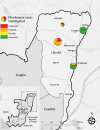Epidemiologic and Ecologic Investigations of Monkeypox, Likouala Department, Republic of the Congo, 2017
- PMID: 30666937
- PMCID: PMC6346463
- DOI: 10.3201/eid2502.181222
Epidemiologic and Ecologic Investigations of Monkeypox, Likouala Department, Republic of the Congo, 2017
Abstract
Monkeypox, caused by a zoonotic orthopoxvirus, is endemic in Central and West Africa. Monkeypox has been sporadically reported in the Republic of the Congo. During March 22-April 5, 2017, we investigated 43 suspected human monkeypox cases. We interviewed suspected case-patients and collected dried blood strips and vesicular and crust specimens (active lesions), which we tested for orthopoxvirus antibodies by ELISA and monkeypox virus and varicella zoster virus DNA by PCR. An ecologic investigation was conducted around Manfouété, and specimens from 105 small mammals were tested for anti-orthopoxvirus antibodies or DNA. Among the suspected human cases, 22 met the confirmed, probable, and possible case definitions. Only 18 patients had available dried blood strips; 100% were IgG positive, and 88.9% (16/18) were IgM positive. Among animals, only specimens from Cricetomys giant pouched rats showed presence of orthopoxvirus antibodies, adding evidence to this species' involvement in the transmission and maintenance of monkeypox virus in nature.
Keywords: Republic of the Congo; ecology; epidemiology; monkeypox; orthopoxvirus; viruses; zoonoses.
Figures



References
MeSH terms
Grants and funding
LinkOut - more resources
Full Text Sources
Medical
Miscellaneous

